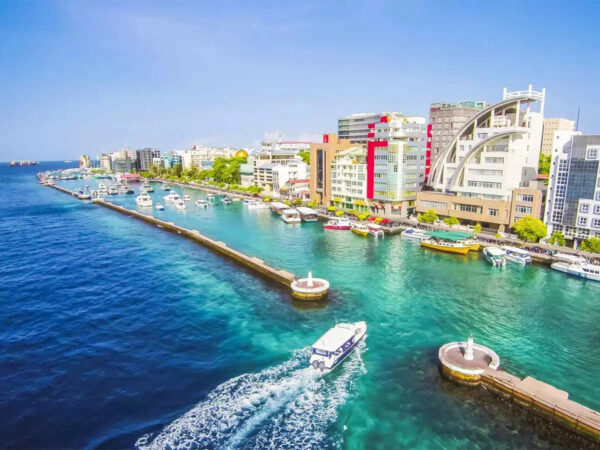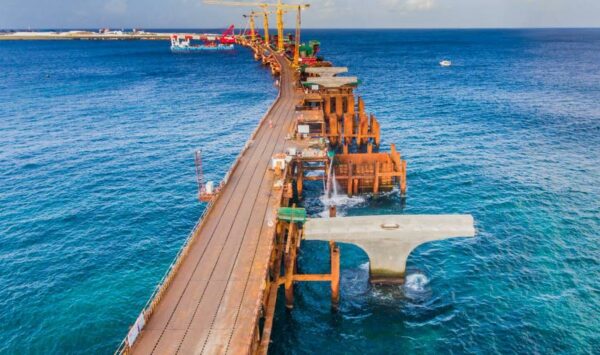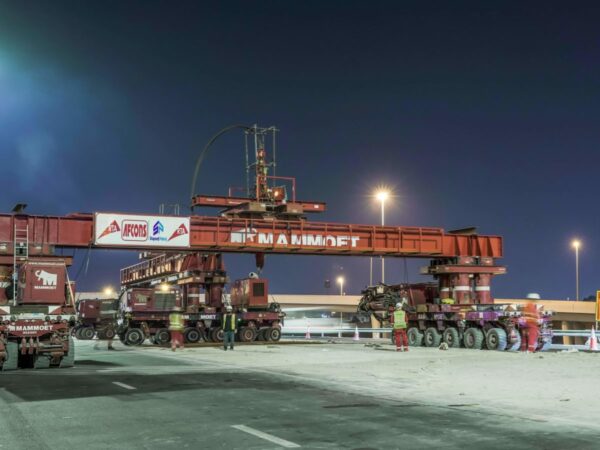GMCP: How profitable is the Greater Male Connectivity Project for India?

Few days back, India and Maldives signed the GMCP deal. It’s been a year since India’s External Affairs Minister, Dr. S. Jaishankar, visited the Maldives. During a meeting with the Maldives Foreign Minister Abdulla Shahid, he declared a $500-million infrastructure project. The Maldives government formally signed an agreement with Mumbai-based company AFCONS to develop the Greater Male Connectivity Project or the GMCP.
This infrastructure project or the GMCP, which is the largest-ever by India in the Maldives, involves constructing a 6.74-km-long bridge and highway link that will connect the capital of Maldives, Male, with the neighboring islands of Villingli, Gulhifalhu, and Thilafushi. The Indian High Commission claimed that the GMCP was financed by India in a gift of $100 million, and with a line of credit of $400 million.

“The Greater Malé Connectivity Project or GMCP promotes the vision of Prime Minister Modi and President Solih for healthy bilateral relations. The roots of the project dates back during the External Affairs Minister’s visit to Malé in September 2019. The GMCP is a solid proof that India is a strong development associate of the Maldives. Not only that, India is has always been the First Responder in times of any emergency in the island country,” Sunjay Sudhir, High Commissioner of India to the Maldives, informed.
“The GMCP is not only the most important project India is doing in the Maldives but also the greatest infrastructure project in the Maldives overall. This iconic project will give a significant increase to the Maldivian economy,” Sudhir added.
About the project

In August last year, New Delhi had decided to support the implementation of this project following a petition from the Maldives government.
This project is essential because it aids inter-island connectivity in the country, stated Dr. Gulbin Sultana, who is a research analyst at the Manohar Parrikar Institute for Defence Studies and Analyses, whose area of research involves the Maldives. Transport is a primary challenge for residents who have to take boats or seaplanes to remote islands. Locals take ferries or boats. It becomes even more challenging during the monsoons when the seas are stormy. This bridge that would link Male with the three neighboring islands would facilitate the process.
The Chinese-built 1.39 km-long Sinamalé Bridge connects Malé with the islands of Hulhulé and Hulhumalé, and this project, which is four times longer, would join the other three islands.
The importance of the GMCP

Approximately 40% of the entire population of the Maldives prevails in Malé, which has an area of about 8.30 square kilometers. Male is one of the most densely populated cities globally, according to a study at the South Asia Center in the University of Pennsylvania.
“Male is overcrowded and land is a major issue. There is very little expanse for the city to expand,” described Sultana.
This pushed the current government in the Maldives to consider decentralization. And the growth of other inhabited islands by furnishing them with civic amenities like hospitals and other institutions and incentivizing people to relocate to other islands, reducing the burden of Male. With this bridge, connectivity and transportation to the capital city would also improve, opening up an alternative transport route, which has been a persistent problem for the country’s people.
What about these islands?
On the island of Gulhifalhu, a port is being built under the Indian line of credit. Located 6 kilometers from Male, since 2016, the island has been promoted by the Maldives government as an important location for production, warehousing, and administration facilities due to its vicinity to the capital city. The state also established basic infrastructure, high-load capacity roads, water and sewage systems, telecommunications networks.
Finances
“Following a five-year grace period, the interest rate is 1.75% and the Maldives has to return it through a 20-year time. In the $500 million, $100 million is a gift, while $400 million is the loan. India is paying so much and so we see the prevailing government explain India’s loans as less expensive and more transparent, unlike China’s,” mentioned Sultana, about Beijing’s debt-trap diplomacy.
Last year, when the deal was first declared, former President of Maldives Mohamed Nasheed, had referred to China’s debt-trap loans to the former Yameen administration in a tweet: “The super low cost development assistance announced by @DrSJaishankar today is exactly what Maldives needs. Real help from a friend, to help us develop critical infrastructure. Rather than eye-wateringly costly financial loans that leaves the country mired in debt. @PMOIndia.”
“Maldives hasn’t actually been clear regarding how much debt they owe to China. Nasheed states that the island nation has a debt of $3.4 billion. However, the Chinese ambassador to the country says it is just $1.4 billion,” Sultana mentioned.
This $500 million has been provided only for the Greater Male Connectivity Project, with millions of dollars pledged by India for other community-focused projects in the country. “When India presents financial assistance, it is always demand-driven. The government of the Maldives chooses what projects they want to use that money for,” Sultana further stated.
Strategies for this Greater Male project date back to 2013, when the Chinese restarted work on the Sinamale Bridge after a brief rest. During the time when the Solih government came into power in 2018, India revealed interest in working on this project and the port in the island of Gulhifalhu. If India doesn’t do this, obviously someone else would have grabbed the opportunity, and we all know the answer. China!
What is at stake

GMCP is not only about an ambitious project including both India and the Maldives. The terms of the deal demand the completion of the bridge by 2023. If Mumbai-based AFCONS defaults to deliver on the deadline, probably, it might not display well on bilateral relations. “That is a dilemma, because countries charge that India doesn’t deliver on projects and they tend to make contrasts with China,” said Sultana. For India, Maldives holds diplomatic importance, and showing that it can deliver would help lessen some concerns in the country.
However, there are also the 2023 presidential elections and the 2024 parliamentary elections in the Maldives. Lately, the India-friendly ruling Maldivian Democratic Party has observed a torn between Nasheed followers and Solih loyalists.
“It would be in India’s concerns to finish the project by 2023, because the MDP couldn’t win the last Male council polls. Male is a significant seat because 40% of the population lives there,” Sultana added. If the opposition PPM were to take power, it would be a reason for concern for India because they are known to be more inclined towards China than India. Even otherwise, it is in India’s interests to confirm that they can meet deadlines of GMCP.




